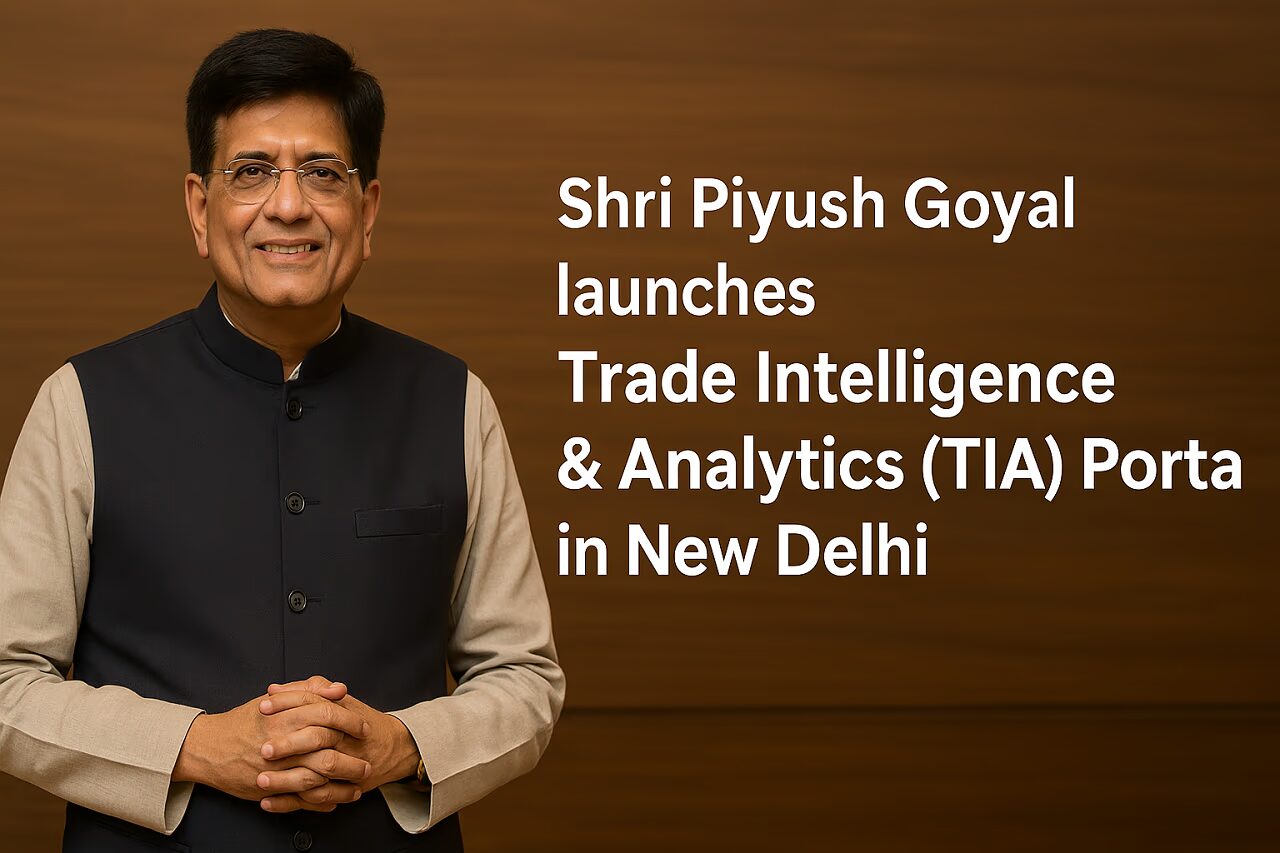
In an essential step for making India’s trading ecosystem much stronger, Union Minister of Commerce and Industry, Shri Piyush Goyal, launched the Trade Intelligence & Analytics (TIA) Portal in New Delhi. The launch is a major milestone in the way businesses, from large corporations to individual startups, access, analyse, and use trade data.
At the same time, Goyal pointed out, transparency in trade data will be an important factor in empowering stakeholders to enable their informed decisions. He emphasised that India would always remain vulnerable to global uncertainties, as long as robust exports could not contribute significantly to foreign exchange reserves. The TIA Portal thus comes in at a time when it is most needed-with advanced tools to help enterprises navigate the global trade landscape.
ALSO READ- A New Era of Data Safety Updated: Digital Personal Data Protection Rules 2025
Why the TIA Portal Matters-
Several crucial reasons highlighted by Shri Piyush Goyal render the portal a game-changer:
- It opens trade data to all and thereby eliminates the information asymmetry existing between big corporates and smaller entities.
- Supports policymaking surrounding trade for adaptive and responsive policies.
- MSMEs and startups are endowed with the insight that was previously enjoyed only by incumbents in the field.
- Export competitiveness shall be strengthened to allow better utilisation of Free Trade Agreements (FTAs) by entrepreneurs.
- Opportunities under the global services trade, a fast-growing sector, will be extended.
A Platform Built for Inclusivity and Transparency-
Data Access for All:
As far as Mr Goyal’s statements could tell, we are sure that even in the most remote corners of India, businesses will now have access to trade intelligence that would have required substantial resources and technology. The TIA Portal would thus democratise information by:
- Putting together several global and bilateral trade databases.
- Integrating UN Comtrade data on a single and unified interface.
- Giving commodity and country-level insights through visual dashboards.
Supporting Small Businesses:
A practical guide to point out potential markets for:
- Learn about demand patterns.
- Track tariff benefits of FTAs.
- Identify new commodity opportunities.
This equalises the ground to make small enterprises more competitive.
A Deep Dive Into the Portal’s Capabilities-
Consolidated & Automated Data Systems:
The TIA Portal is a very central digital platform dedicated to automating processes that are traditionally manual in terms of trade analysis. Important features include:
- 270+ interactive visualisations
- 28+ dashboards
- Automated monthly trade reports with volume exceeding 300 pages
- Automated surge reports based on trade alerts
- Seamless extraction and downloading of trade data
- Integrated database of multiple global and bilateral databases
Enhanced Tools for Market Intelligence:
The portal includes several specialised tools to help stakeholders identify opportunities and trends:
Trade Watch Tower:
- Highlights the most sought-after “Champion Products”
- Another effort could be to link India’s export strengths with global markets.
Surge Monitoring Tools:
- Keep an eye on rare customs import/export movements.
- Place “Look out” and “Say go” on any known time-related aspect.
Production Linked Incentive (PLI) Dashboard:
Monitor them for commercial performance with the commodities of interest, some of which are under PLI.
Critical Minerals Dashboard:
- Covers 30+ critical minerals.
- Maps India’s sourcing and global trade flows at the HS code level.
Tariff Analysis & Target Monitoring Dashboards (Upcoming):
- Provide tariff insights.
- Track performance indicators for export growth.
ALSO READ- WHO Reports Historic Fall in India’s TB Cases in 2025
Advanced Analytics for Stronger Policy and Planning-
The TIA Portal integrates globally recognised trade indices, allowing for more sophisticated analysis:
Key Trade Indices Included:
- Trade Complementarity Index (TCI): Indicates how much the export strengths of India match the demand from a partner country.
- Revealed Comparative Advantage (RCA): India indicates where it has a competitive trade edge.
- Trade Intensity Index (TII): A measure of India’s strength of bilateral trade relative to global flows.
These indices offer deep insights that help:
- Policymakers refine trade agreements.
- Exporters choose high-potential markets.
- Industry bodies plan targeted interventions.

Promoting Evidence-Based Policymaking-
The Department of Commerce recognised the urgent need for a robust digital trade intelligence framework. The portal was thus conceptualised in March 2024 and built to enable:
- Henceforth, faster policy responses to changes that happen in global trade.
- Targeted interventions in sectors.
- Automated workflows to reduce manual effort and improve efficiency.
- Unified data access, replacing several old systems like the Niryat Portal, Tradestat, and Monitoring Dashboards.
Thus, going from fragmented data tools to a single integrated platform, the Ministry envisions an ecosystem where any and every decision regarding trade is backed by accurate and real-time data.
A Cost-Effective, Open-Source Model-
One of the standout features of the TIA Portal is its sustainable, cost-effective design:
- Open-source technologies were used for its development.
- The portal shall be operated without payment of any license fee for an indefinite period.
- Operational cost savings owing to minimal server infrastructure.
- Scalable and accessible by design.
- Ensuring long-term viability provides an exemplary model for future government technology initiatives.
Government and Business Partnership: A Call for Action-
Shri Piyush Goyal urged industry members to demand more from the government so that improvements take place immediately. He reaffirmed the ministry’s sincerity in resolving the issues: Internal matters – sorted quickly. Inter-departmental matters – Commerce will coordinate with other ministries.
Piyush Goyal called the present tariff situation globally a “wake-up call” for India to proactively take advantage of opportunities rather than lamenting the ones lost.

Conclusion-
This scenario will mark the undertaking of the Trade Intelligence & Analytics (TIA) Portal, which will democratise trade intelligence access, empower the small business owner, and enhance India’s competitiveness in world trade.
This portal incorporates the transparent, inclusive, and data-driven nature of trade, which India envisages and promises to be in terms of great empowerment for smarter, evidence-based policymaking.
